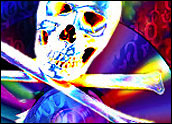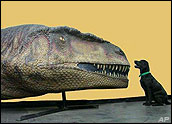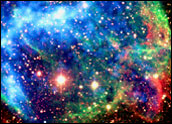
People who have had “near-death experiences” (NDEs) often report seeing a light at the end of a dark tunnel. TV shows, movies and books drill this crossing-over concept into viewers’ minds. However, a study published in Neurology, a scientific journal of the American Academy of Neurology, finds that these events have a biological explanation.
A near-death experience is defined as “a time during a life-threatening episode of danger, such as a car accident or heart attack, when a person experienced a variety of feelings including [the] sense of being outside of one’s physical body, unusual alertness, seeing intense light, and a feeling of peace,” according to the study.
REM Intrusion
The part of the brain that manages the different states of awareness is known as the arousal system. It functions during REM (rapid-eye movement) sleep and while a person is awake and alert.
“The arousal system is also critical in the behavioral response to stress,” said Kevin R. Nelson, M.D., study author and neurologist at the University of Kentucky at Lexington.
It lives in the brain stem, and controls the heart and respiratory functions. When stimulating the nerve from the heart and lungs, it creates an instant REM-state intrusion — the combination of feeling asleep and awake at the same time, Nelson explained.
“One of the basic features of REM state is activation of the visual system,” he told TechNewsWorld. “REM-state intrusion could promote the prominent visual phenomena of near death experience.”
Association, Not Proof
The researchers compared two groups of similar ages and genders. One group was comprised of 55 people who had reported having an NDE, while the 55 comprising the other group had not.
Sixty percent of the study participants who claimed they had NDE reported that they simultaneously sensed sleep and wakefulness, or REM intrusion.
Among those who did not have NDEs, only 24 percent reported sleep disruption.
“It is not clear — nor do the authors specifically claim — that NDEs are caused by the same mechanisms associated with REM sleep,” said Andrew Newberg, M.D., associate professor of radiology and psychology at the University of Pennsylvania.
“That there is an association is interesting — although even though it is statistically greater in NDErs than in controls, the relationship only occurs in about half of people who have had NDEs,” he told TechNewsWorld.
Other Links
The arousal system is connected to central nervous system cardio-respiratory control.REM intrusion is a sleeping disorder that has also been associated with narcolepsy and Parkinson’s disease. It has also been reported in conjunction with some fainting experiences.
Ten percent of heart attack survivors say they have had an NDE.
“The paradox of the [NDE] hypothesis is that most investigators have focused on the most highly developed regions of the brain, whereas REM intrusion hypothesis and involvement of the arousal systems focus on the ‘primitive’ portions concerned with the ‘fight-or-flight’ response,” Nelson remarked.
The researchers want to understand what creates near-death experiences — the “how” rather than the “why.”
“This type of study, while interesting, does not write off such experiences as purely neurological, nor does it suggest that such experiences are real,” explained Newberg.





















































The suggestion that arousal system disturbances may cause out-of-body experiences (OBE’s) is a classic example of mistaking correlation for causation in an effort to dismiss an experience that challenges the predominant materialistic, reductionist Cartesian-Newtonian paradigm.
As someone who has been developing the ability to have will-induced, conscious out-of-body experiences and has been investigating the matter for a decade, it is no news that OBE’s can be triggered in many ways: spontaneously and unexpectedly, by will, or even "forced" (near-death experience).
Indeed, sleep paralysis can be related to the out-of-body experience (which is why it is also referred to as projective catalepsy in this context). However, it does not happen every time one has an OBE. It is quite the opposite: according to projectiogists (scientists who study the OBE as an objective phenomenon), when someone experiences projective catalepsy, they are partially out of the body. Anyone can verify this fact through several personal experiences.
Scientist who attempt to reduce the OBE to neurophysiology do not have frequent, lucid, will-induced OBE’s that would reveal it as an objective, albeit more subtle, reality AM enable to scientific study through corroboration of personal experiences.
Nelson Abreu, Instructor & Investigator
International Academy of Consciousness